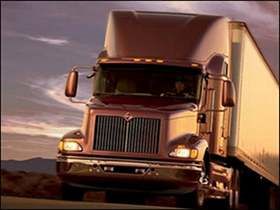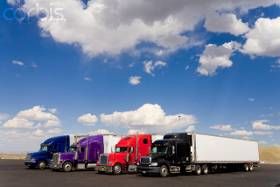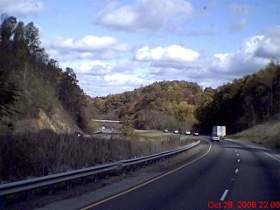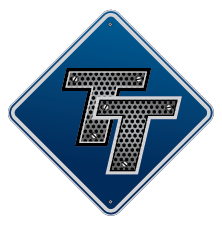Prosthetic Clutch Leg
Topic 1264 | Page 1

I don't know but you should search for the DOT physical info. I don't recall the site but there is a page that has the rundown of the physical and may give you a little clarity. You could also call a doctor that does DOT physicals and ask.
Hopefully it works out for you.
DOT:
Department Of Transportation
A department of the federal executive branch responsible for the national highways and for railroad and airline safety. It also manages Amtrak, the national railroad system, and the Coast Guard.
State and Federal DOT Officers are responsible for commercial vehicle enforcement. "The truck police" you could call them.
It appears that with the proper qualification you can drive a commercial vehicle.
The physical qualifications for truck driving states:
(1) Has no loss of a foot, a leg, a hand, or an arm, or has been granted a skill performance evaluation certificate pursuant to § 391.49;
391.49 Alternative physical qualification standards for the loss or impairment of limbs states:
A person who is not physically qualified to drive under §391.41(b)(1) or (b)(2) and who is otherwise qualified to drive a commercial motor vehicle , may drive a commercial motor vehicle, if the Division Administrator, FMCSA , has granted a Skill Performance Evaluation (SPE) Certificate to that person.
So you'll have to do a little research into getting that SPI Certificate which will allow you to drive.
As far as the effort and fatigue involved with pushing the clutch in, if you can do squats pretty well then you'll be fine. It takes a good bit of effort to push in a clutch but if you can do squats where you can get your knees past 90 degrees (like sitting in a chair) and stand back up repeatedly you should be fine.
In the beginning, during your training, you'll have to double clutch which means clutching twice for every gear shift. It's quite tiring on the leg until you get used to it. Ironically, by the time you get used to it you won't have to do it anymore because 99.9% of the drivers out there "float" the gears, meaning they shift without using the clutch at all. So once you're finished with training and running solo you'll hardly ever have to use the clutch. Generally only when coming to a complete stop.
Commercial Motor Vehicle:
A commercial motor vehicle is any vehicle used in commerce to transport passengers or property with either:
- A gross vehicle weight rating of 26,001 pounds or more
- A gross combination weight rating of 26,001 pounds or more which includes a towed unit with a gross vehicle weight rating of more than 10,000 pounds
CSA:
Compliance, Safety, Accountability (CSA)
The CSA is a Federal Motor Carrier Safety Administration (FMCSA) initiative to improve large truck and bus safety and ultimately reduce crashes, injuries, and fatalities that are related to commercial motor vehicle
FMCSA:
Federal Motor Carrier Safety Administration
The FMCSA was established within the Department of Transportation on January 1, 2000. Their primary mission is to prevent commercial motor vehicle-related fatalities and injuries.
What Does The FMCSA Do?
- Commercial Drivers' Licenses
- Data and Analysis
- Regulatory Compliance and Enforcement
- Research and Technology
- Safety Assistance
- Support and Information Sharing
DOT:
Department Of Transportation
A department of the federal executive branch responsible for the national highways and for railroad and airline safety. It also manages Amtrak, the national railroad system, and the Coast Guard.
State and Federal DOT Officers are responsible for commercial vehicle enforcement. "The truck police" you could call them.
Double Clutch:
To engage and then disengage the clutch twice for every gear change.
When double clutching you will push in the clutch, take the gearshift out of gear, release the clutch, press the clutch in again, shift the gearshift into the next gear, then release the clutch.
This is done on standard transmissions which do not have synchronizers in them, like those found in almost all Class A trucks.
Dm:
Dispatcher, Fleet Manager, Driver Manager
The primary person a driver communicates with at his/her company. A dispatcher can play many roles, depending on the company's structure. Dispatchers may assign freight, file requests for home time, relay messages between the driver and management, inform customer service of any delays, change appointment times, and report information to the load planners.Fm:
Dispatcher, Fleet Manager, Driver Manager
The primary person a driver communicates with at his/her company. A dispatcher can play many roles, depending on the company's structure. Dispatchers may assign freight, file requests for home time, relay messages between the driver and management, inform customer service of any delays, change appointment times, and report information to the load planners.TWIC:
Transportation Worker Identification Credential
Truck drivers who regularly pick up from or deliver to the shipping ports will often be required to carry a TWIC card.
Your TWIC is a tamper-resistant biometric card which acts as both your identification in secure areas, as well as an indicator of you having passed the necessary security clearance. TWIC cards are valid for five years. The issuance of TWIC cards is overseen by the Transportation Security Administration and the Department of Homeland Security.

How does "float the gears" work? I've seen that term a few times...
Float The Gears:
An expression used to describe someone who is shifting gears without using the clutch at all. Drivers are taught to "Double Clutch" or press and release the clutch twice for each gear shift. If you're floating gears it means you're simply shifting without using the clutch at all.
How does "float the gears" work? I've seen that term a few times...
You're just shifting without using the clutch. There really isn't anything you're doing differently than when you're double clutching. You're just not using the clutch. When you shift a truck properly there's no need to use the clutch. I guess they still teach double-clutching so people know it, but the last time I double-clutched was when I was taking my CDL exam to get my license in August of 1993. Honest to God.
The first day I went on the road with my trainer he said, "You can float the gears. Don't worry about that double-clutching garbage. Nobody does that." I was glad to hear that because I knew you could float the gears but I didn't know how he would feel about it.
CDL:
Commercial Driver's License (CDL)
A CDL is required to drive any of the following vehicles:
- Any combination of vehicles with a gross combined weight rating (GCWR) of 26,001 or more pounds, providing the gross vehicle weight rating (GVWR) of the vehicle being towed is in excess of 10,000 pounds.
- Any single vehicle with a GVWR of 26,001 or more pounds, or any such vehicle towing another not in excess of 10,000 pounds.
- Any vehicle, regardless of size, designed to transport 16 or more persons, including the driver.
- Any vehicle required by federal regulations to be placarded while transporting hazardous materials.
Float The Gears:
An expression used to describe someone who is shifting gears without using the clutch at all. Drivers are taught to "Double Clutch" or press and release the clutch twice for each gear shift. If you're floating gears it means you're simply shifting without using the clutch at all.
Double Clutch:
To engage and then disengage the clutch twice for every gear change.
When double clutching you will push in the clutch, take the gearshift out of gear, release the clutch, press the clutch in again, shift the gearshift into the next gear, then release the clutch.
This is done on standard transmissions which do not have synchronizers in them, like those found in almost all Class A trucks.
Double Clutching:
To engage and then disengage the clutch twice for every gear change.
When double clutching you will push in the clutch, take the gearshift out of gear, release the clutch, press the clutch in again, shift the gearshift into the next gear, then release the clutch.
This is done on standard transmissions which do not have synchronizers in them, like those found in almost all Class A trucks.

While we were otr , I've seen a few trucks that had wheel chair lifts on them...I never saw what they were for, and they were all O/O...but sure makes ya wonder... TSB just said he knew a o/o who was in a wheelchair pulling a drop deck. He sez he watched him chain down a load of reels...it was fascinating. Now how he cleared it all with the DOT , or if he was a state only driver, we don't know. But if theres a will there should be a way !!!! On another note...With all our wounded warriors coming back from combat, missing limbs, I'm sure theres gonna be a bunch of them that will be looking for the solitude of truck driving....Hopefully the Government will see its way clear to see that with new prosthetics, there is alot more that an amputee can do.....
OTR:
Over The Road
OTR driving normally means you'll be hauling freight to various customers throughout your company's hauling region. It often entails being gone from home for two to three weeks at a time.
DOT:
Department Of Transportation
A department of the federal executive branch responsible for the national highways and for railroad and airline safety. It also manages Amtrak, the national railroad system, and the Coast Guard.
State and Federal DOT Officers are responsible for commercial vehicle enforcement. "The truck police" you could call them.

I'm 57, worked construction/engineering/remodel for the last 40 years for myself and employers. 38 of those years has been on a prosthetic left leg as a result of an above knee amputation from a bike accident. I have been out of work since March, and have been considering applying for disability as I don't feel I can effectively perform the rigors of construction as I once could and I certainly can't keep up with the young bucks (although I could teach them a thing or two). I'm in good health and I still keep myself busy with side work that isn't quite as demanding.
Although I feel it's the end of the road for my construction career, I would much rather draw a paycheck than a disability check and have always had an interest in over the road truck driving but didn't think I would be eligible due to the prosthetic leg. Most of my vehicles including my present '86 F-250 have been manual shift.
I absolutely love driving and take it very seriously and have always enjoyed the open road. So, I am hoping someone could tell me what the chances are of the DOT and/or a perspective trucking company allowing me to drive. I don't want to get my hopes up or waste my or someone else's time training for a CDL if there is no possibility of driving.
Thanks for your time. I really enjoy your site and have found it very informative.
Since I'm looking at being laid off work (again), I've thought about going back to trucking school and getting my CDL. Ron P., did you get your CDL and did you find work as a trucker? I'm afriad that I'll spend all the time and money to get the CDL only to find no company will hire me. I have a friend who's a LAK that's still driving but he had his CDL long before his accident. I guess working the clutch and floating the gears won't be a major problem considering my friend doesn't have any problems. I've been told a lot of companies are going with automatics now, which would be even better.
I only have about 10 more years till I can retire. I'm tired of being laid off every two to four years. I want something I can do until I can retire.
Thanks everyone
CDL:
Commercial Driver's License (CDL)
A CDL is required to drive any of the following vehicles:
- Any combination of vehicles with a gross combined weight rating (GCWR) of 26,001 or more pounds, providing the gross vehicle weight rating (GVWR) of the vehicle being towed is in excess of 10,000 pounds.
- Any single vehicle with a GVWR of 26,001 or more pounds, or any such vehicle towing another not in excess of 10,000 pounds.
- Any vehicle, regardless of size, designed to transport 16 or more persons, including the driver.
- Any vehicle required by federal regulations to be placarded while transporting hazardous materials.
Over The Road:
Over The Road
OTR driving normally means you'll be hauling freight to various customers throughout your company's hauling region. It often entails being gone from home for two to three weeks at a time.
DOT:
Department Of Transportation
A department of the federal executive branch responsible for the national highways and for railroad and airline safety. It also manages Amtrak, the national railroad system, and the Coast Guard.
State and Federal DOT Officers are responsible for commercial vehicle enforcement. "The truck police" you could call them.
HOS:
Hours Of Service
HOS refers to the logbook hours of service regulations.OWI:
Operating While Intoxicated
New Reply:
New! Check out our help videos for a better understanding of our forum features

















Preview:








 TT On Facebook
TT On Facebook
I'm 57, worked construction/engineering/remodel for the last 40 years for myself and employers. 38 of those years has been on a prosthetic left leg as a result of an above knee amputation from a bike accident. I have been out of work since March, and have been considering applying for disability as I don't feel I can effectively perform the rigors of construction as I once could and I certainly can't keep up with the young bucks (although I could teach them a thing or two). I'm in good health and I still keep myself busy with side work that isn't quite as demanding.
Although I feel it's the end of the road for my construction career, I would much rather draw a paycheck than a disability check and have always had an interest in over the road truck driving but didn't think I would be eligible due to the prosthetic leg. Most of my vehicles including my present '86 F-250 have been manual shift.
I absolutely love driving and take it very seriously and have always enjoyed the open road. So, I am hoping someone could tell me what the chances are of the DOT and/or a perspective trucking company allowing me to drive. I don't want to get my hopes up or waste my or someone else's time training for a CDL if there is no possibility of driving.
Thanks for your time. I really enjoy your site and have found it very informative.
CDL:
Commercial Driver's License (CDL)
A CDL is required to drive any of the following vehicles:
Over The Road:
Over The Road
OTR driving normally means you'll be hauling freight to various customers throughout your company's hauling region. It often entails being gone from home for two to three weeks at a time.
DOT:
Department Of Transportation
A department of the federal executive branch responsible for the national highways and for railroad and airline safety. It also manages Amtrak, the national railroad system, and the Coast Guard.
State and Federal DOT Officers are responsible for commercial vehicle enforcement. "The truck police" you could call them.
HOS:
Hours Of Service
HOS refers to the logbook hours of service regulations.OWI:
Operating While Intoxicated